#earth is flat
Explore tagged Tumblr posts
Text
Martha Blogs Part1
Hey honnie bunnies how are yall today! I am very angry! i went to my sons liberal school to observe his geography clas. I walk into the class xcited to see my baby boy and this foreign teacher who barely speaks a word of english.... started to tell my son and his friends rthat this big fat round ball was the earth and i told him hes a crazy man!!
He was spreading all these lies and conspiricies about the earth being a big fat ball just like his stomach when the actual smart people knew that the earth is flat.. I mean,, if the earth was round how are we walking all over it like this is crazy talk! If we trioed to walk on something round we would just fall right off into space . AM I RIGHT??!!!
#chad t#chad t with the double es#blessed#babby boy#my son#earth is flat#earth#martha blogs#christian#christianity rules
11 notes
·
View notes
Text






something something ... Stanford "Why didn't Rudolf just kill the other reindeer?" Pines and Fiddleford "I create death-mechas when my feelings get hurt" McGucket
#i like to imagine that stan has to be the one to bring these two nerds back down to earth when things get too out of hand#like hes all for “light violence” but THOSE TWO tend to take it to the extreme and he aint into all that lmao#i also like to imagine that mabel would be just as deranged as ford and fidds#<- literally screams “DEATH” as Blendin's punishment after Globnar so i think it would be in character for her lmao#not that the kids would actually flat out murder someone#but they'd probs end up planning one in excrutiating detail#to the point where stan has to be like “okay this is getting TOO REAL guys.. ”#gravity falls#gravity falls au#relativity falls#stanford pines#stanley pines#fiddleford mcgucket
5K notes
·
View notes
Text

My girlfriend had a comic idea and I just HAD to translate and draw it
3K notes
·
View notes
Text
BACK IN THE FUCKING BUILDING AGAAAIINN
#my art#dsmp#mcyt#dsmp fanart#dream smp fanart#mcyt fanart#chappyduo#skephalo#skephalo fanart#dream smp#happyduo#time is a loop the earth is flat. what fucking ever
937 notes
·
View notes
Text

Sebastian being a menace Pt. 2
#sinsydia#sdv sebastian#sebastian sdv#sebastian stardew valley#stardew valley sebastian#demetrius sdv#i saw this post on reddit that robin would say this to demetrius. WRONG. sebastian would. and hed do it right infront of his salad too#demetrius has a chronic “i have to correct you with facts problem” and i think sebastian knows this so he's testing him here#and robin knows this and shes probably looking at demetrius like “honey... honey please”#sebastian does not believe the earth is flat. sorry flat earthers lmao#anyways everyone have a lovely ass day
2K notes
·
View notes
Text
Today I'm working myself into a proper tizzy because all of a sudden that everyone hates him, people have Realized that Gaiman badly ripped much of The Sandman off of Tanith Lee's glorious Tales From the Flat Earth.
She's dead now and it's too late to give her justice.
Twenty-year-old Gen, reading Sandman for the first time, knew that he was just a poor copy of Azhrarn the Beautiful, Lord of Wickedness, and that Death was Azhriaz, and Delirium was very like Chuuz, Lord of Delusion, and that Destiny was nearly a one-to-one copy of Lee's Destiny, and that aesthetically and structurally the Sandman just...stole, hand over hand, from Lee's masterwork. It was obvious.
I just figured nobody cared.
I have loved a lot of Gaiman's work. I won't pretend I always hated him, even if for the last fifteen or twenty years I've thought he was largely up his own butt. I'll probably have some of his poetry memorized for the rest of my life. But it galls me that now that everyone is taking up pitchforks and torches, NOW he's being called out for stealing from a woman who deserved much better, when it was obvious to me when I was barely out of childhood, more than twenty years ago.
#tanith lee#neil gaiman#tales from the flat earth#sandman#gaiman#I need a better word than#plagiarism#though a friend of hers says he did sometimes steal from her word-for-word
599 notes
·
View notes
Text
Shifttok out there arguing over shifting being a genetic trait and Shiftblr is just here like,

What in the actual fawk are they talking about?? LMAO
#For the record it's the biggest load of bullshit since flat earth girly dont even worry about it <3#shiftblr#reality shifting#shifting memes#shifting#shifting motivation#shifting realities#shifting community#desired reality#reality shift
889 notes
·
View notes
Text

Flat Earth theory: the world is flat.
Cat Earth theory: the world is cat, and it's playing with Australia.
448 notes
·
View notes
Text

8K notes
·
View notes
Text
I have a friend whose ex, a minor celebrity in some circles, was abusive.
Shortly after she and some other women went public about it, there were some people who chimed in talking about other misdeeds of his.
Her ex was, and is, a loathsome waste of oxygen, and the words, "...who deserves every accusation leveled at him" would almost escape my lips...
...Except that some of the accusations people began throwing around because they (understandably) hated this guy weren't true.
This did not help my friend at all! It muddied the waters, and gave her awful ex ammunition for his claims that people were just out to get him, and were willing to make stuff up to smear him.
Switching gears: there's been a lot of discussion recently about how some brilliant and influential art has been created by objectively terrible people. Part of that discussion has been calling out people who say, "Their work always sucked," or "I never liked it." Not only are statements like this unhelpful, they provide cover for predators. If you insist that your tastes reflect your morality, you're giving yourself a huge blind spot, and making it easy to dismiss evidence of harm done by creators you happen to like.
This is one reason why I think exhibits like this one are important: they help teach that lesson.
Three notes on this: 1. by the time of that exhibition, Gill was long dead and therefore unable to profit from it.
2. This kind of thing isn't necessary for every artist, because not every creator does heinous things.
3. My friend's ex is nowhere near the artistic league of Eric Gill or any of the other creators I'll discuss.
Switching gears again...
If someone mentions a bespectacled British boy wizard with an owl familiar, in a modern setting with "secret world" magic, the name that springs to mind is most likely "Harry Potter", right?
But Timothy Hunter, from The Books of Magic, was published a full seven years before that. I was working in a bookstore when the novelizations for the BoM comics came out, and had to tell kids that no, this was not a HP rip-off.
I don't think the reverse was true, either: for one thing, The Books of Magic is set in the DC Universe, and I've never heard of JKR reading superhero comics. But also... sometimes completely separate creators will come up with strikingly similar ideas, utterly by coincidence. It's one reason why most authors tell fans NOT to send them ideas or fanfiction based on their work: there is rarely any good way to prove that you didn't steal a concept.
Now, obviously every creator is influenced by other people's works, and I completely agree that it's good to acknowledge that and to point fans towards your influences!
When Rowling began channeling her resources into making life worse for trans folk, I saw a lot of people saying, "Well, Harry Potter was just a mediocre rip-off of The Worst Witch anyway."
While I haven't read that series, I strongly doubt this claim. The idea of magic schools is older and more widespread than either of those series, and "British boarding school hijinks, but it's a magic school" was bound to be written more than once.
Now, some of you already know, and others have looked up, who originally wrote Tim Hunter. And... yeah, it's Neil Gaiman. *sigh*
In the last few days, I've seen some people saying, "The Sandman ripped off Tanith Lee's Tales from the Flat Earth." They cite a number of similarities: Azhrarn, the Lord of Darkness, is a pale-skinned, raven-haired Byronic figure with a sibling-like relationship to the Lord of Death and the Lord of Madness. Like the Endless, these beings are god-like, but specifically not gods. Apparently some people have mistaken fanart of Azhrarn for Morpheus. And Chuz, Prince Madness, has a bisected appearance, half his face horribly messed up, like the demoness Mazikeen.
But speaking as someone who was a fan of the late Tanith Lee years before I picked up an issue of The Sandman: I don't believe the latter was stolen from the former. Are there similarities? Yes, but they're superficial. If you've read both series, as I have, you'll know that the stories, settings, and characters are very different!
It's possible Gaiman was influenced by Lee's writing, and if so, I agree he should have acknowledged that. He did promote the work of other female creators, which is one reason why many of us thought he was "one of the good ones". But it's also entirely possible that these two authors independently came up with similar ideas.
When it comes right down to it, I think that statements like this -- "their best work was just a rip-off of something else" -- are just another variant of "their work always sucked".
It's often an easier accusation than "they've always been crap", because, as I said, writers come up with strikingly similar concepts all the time, and it's very hard to prove you didn't steal an idea. But it has the same problems, so -- barring the kind of case you could make with a college-level plagiarism-catching program -- I think it's best avoided.
Now, telling people, "Hey, are you sad about this creator turning out to be an awful person to whom you don't want to give any more money? Try this other person's work instead!" This is good! Let's have more of it!
Addendum 1: I think "separate the art from the artist" should mean, "you don't have to treat books already on your shelf as if they're suddenly coated in poison", not "I'm going to ignore this creator's actions and keep buying their products anyway."
Addendum 2: I just posted a version of this to Bluesky.
#tanith lee#tales from the flat earth#harry potter#timothy hunter#eric gill#the sandman#neil gaiman#books and reading#comic books
233 notes
·
View notes
Text

My latest art/oc, she's also really really good at DDR lmao for Helldivers
823 notes
·
View notes
Text
A Glimpse Of What's Beyond The Antarctic Ice Wall 👆
There is warm water and places without ice beyond the ice region 🤔
#pay attention#educate yourselves#educate yourself#knowledge is power#reeducate yourself#reeducate yourselves#think about it#think for yourselves#think for yourself#do your homework#do some research#do your own research#ask yourself questions#question everything#earth#flat earth#you decide#intuition
505 notes
·
View notes
Text

Lumini angst? Anyone want some lumini angst? (Lyrics are from "Paper Doll" by Flower Face)
#xero creations#these lyrics fucked me so bad when i Processed them and for a while i was trying to click it into place as lunar and eclipse#BUT THEN IT HIT ME. and i got so emotional i made this in like 30 minutes flat......#flower face never fails to make songs that make me want to gnaw my arms off /pos#lunar and earth show#the lunar and earth show#tlaes#laes#lumini#gemini x lunar#lunar x gemini#angst
158 notes
·
View notes
Note
Angry crying alone Hiccup???? Pls????
I AM IN LOVE WITH YOUR ART

May I offer this
#WIUDHEUYGDEUY LOOK AT HIM#GET WHUMPED#WHAT A LOSER#Theories on what he’s crying over?#Personally mine is he found out the Earth isn’t flat and celestial bodies exist#httyd#how to train your dragon#hiccup#hiccup haddock#httyd hiccup#art#digital art#my art#hiccup httyd#my artwork#But if I’m gonna be serious#he’s actually crying cuz he’s stressed#let the man cry#hiccup rtte#hiccup whump#how to train your dragon hiccup#hiccup how to train your dragon#httyd art#httyd fandom#httyd fanart#httyd rtte#Rtte#race to the edge httyd#race to the edge#whump
177 notes
·
View notes
Text
Worldbuilding in Flat Worlds
Oh, so you think I can't do worldbuilding on flat worlds?
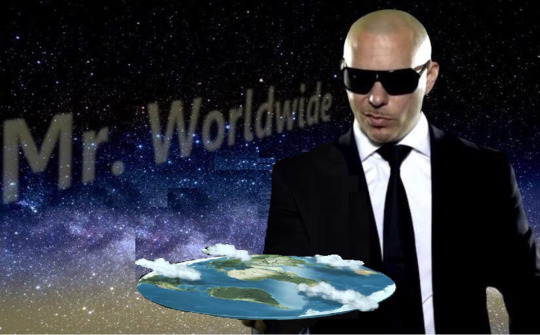
So, you might or might not have run into my rather hyperbolic advice that the first rule of worldbuilding is placing your equator. I still stand for it, and one of these days I would like to expand on that… But many on the notes have asked, and this is fair since it's worldbuilding: what about if my world is flat? Or a cylinder, or a ring, or other such shapes? While I can't cover every shape here (though I would like to try, eventually) I can tell you one thing or two about Flat Earths, Flat Worlds, Disc Worlds, however you would like to call them, and how you can do worldbuilding on them. You will be surprised at how much myth, fantasy and science fiction can mesh here. I apologize in advance for the lack of hard numbers in such things like gravity and orbits, but I can expand if you'd like.
This is going to be a LONG post, so more, way more, under the cut:
First of all, of course many cultures have thought of the Earth as flat, it makes intiutive sense. But this idea wasn't only about a flat Earth as a disc in the middle of nothing. This belief was also accompanied by many other beliefs about the sky, and what's under the earth (while I don't want to generalize, you see this sky-earth-underground motif in most cultures) and how the gods or God shaped it; so, not only the shape of the Earth, but the entire universe, a cosmology. While I could go into much depth on various cosmologies around the world (though I suggest you do!), I will explain the two "flat earths" that are more familiar to us in the Western world; the Hebrew and the Greek cosmology.
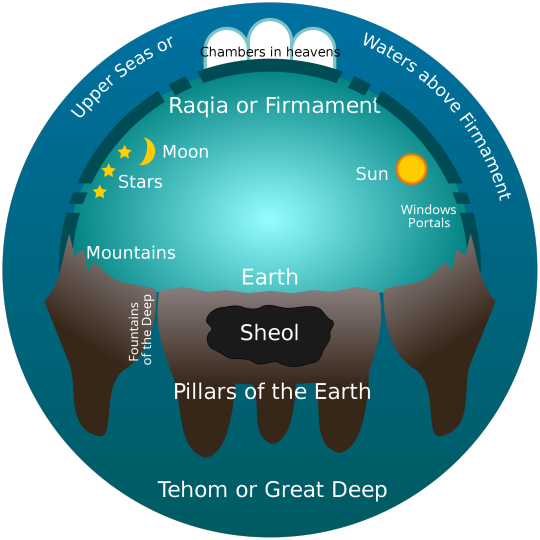
They usually don't teach you the cool lore in Sunday school.
So, what we see in the Hebrew cosmology is a flat earth, yes, but with a firmament that, unlike some might think, does not separate the heavens (as in sky) from the Earth, but rather creates a "vault" with Earth inside from the primeval ocean, as the firmament IS the sky. As you can read in Genesis 1:6-8, in the second day of creation, God divides the waters "under" and "above" the firmament. This idea of a primeval, chaotic ocean from where the creator God(s) create the world is a feature of Mesopotamian mythology (as well as many other unrelated mythologies), and I would love to expand on it, but let's focus on what the "flat" Earth looked like to the ancient Hebrews. You have a flat earth with the foundations on an endless abyss of water, which goes all around the firmament, an inmovable (the Bible mentions this several times) sky where God placed the Sun and Moon and stars to illuminate the Earth, and floodgates where the water for rain, hail and snow (and also the Great Flood) came from. And also Sheol, and the abyss of water, which along with the "heavens" in or beyond the firmament, take into more spiritual characteristics. I could go on, but as you can already see, this is a very complex cosmology, far from a single flat disc floating on nothingness.
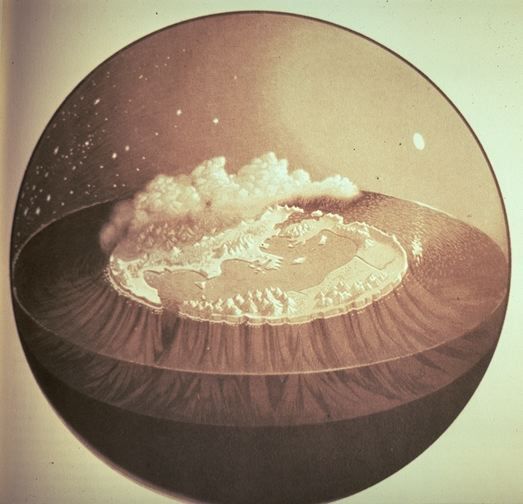
The world according to Homer (the other one)
Let's move on to the Greeks. Now, the ancient Greeks, like Homer, initially seemed to believe in a flat earth, with many parallels to the Mesopotamian (and Hebrew) conception of the world, with a firmament and a landmass surrounded by (or floating on, as per Thales who believed EVERYTHING WAS WATER) an ocean with Greece as the center (see below). However, this conception evolved over time. Anaximander imagined the Earth at the top of a cylindrical, inmovable pillar, but more interestingly, attempted to explain the movement of the Sun and the Moon, believing them to be, to quote Wikipedia, "circular open vents in tubular rings of fire enclosed in tubes of condensed air" surrounding Earth. This idea was later refined by Plato and Aristotle as 'celestial spheres' as paths for the planets (this included the Sun and the Moon) to wander. This concept was further explored by Plato, Aristotle, and many more, to extend to the rest of the planets (which also included the Sun and the Moon), as objects moving across "celestial spheres" inside an sphererical firmament. At this point, Greek philosophers were already thinking the Earth was some sort of sphere, even if only because a sphere was considered the 'ideal' shape, but also because they had started to notice that the Moon was also spherical, boats went under the horizon, and the shadow of Earth during eclipses was round, among many other things that current Flat Earthers don't care about. Eratosthenes was the first to calculate the sphere of the Earth with remarkable precision (you probably know this story if you've watched the old Cosmos with Carl Sagan), and from there, it was mostly accepted in the Hellenistic world that the Earth was in fact round. It was finally Ptolemy by his incredibly detailed astronomical work for the time who finally cemented this system of a round (NOT FLAT!) and unmoving Earth as the center of the universe and the celestial spheres.

The Ptolemaic Universe. Not flat! Notice that the sphere right above Earth is on fire. This is because Earth was believed to be composed of the most base classical elements (Earth and Water), surrounded by a sphere of Air, and then later the sphere of Fire where the Sun orbited. The rest of the spheres were often associated with "Aether" or "crystal", but that's for another time.
As a note, as the Hebrews entered in contact with Hellenistic and later Roman civilization, they also adopted the concepts of the round earth and the "celestial spheres", which meshed really well with the concept of "the heavens" and the "circle of the Earth" mentioned in the Bible. With the rise of Christianity, this fusion of biblical and hellenistic cosmology endured for a long time. It's a myth that medieval Europe thought the Earth was flat, they all knew and teached the Earth was round… and fixed as the center of an universe made up of celestial spheres inside an spherical firmament of fixed stars. That concept endured much longer in Western thought, but that's for another time.
One interesting thing about flat earths in ancient cosomologies is that they often took the form of a circle, and that circle had a center. The center of the world. For the Greeks, it was the Omphalos stone in Delphi (this is where the expression 'navel of the world' comes from). For the Hebrews, it was the Temple at Jerusalem, and later medieval Christian maps (the T-O maps) set Jerusalem as the center of the world. This concept of a 'center of the world' in comparative mythology is called 'axis mundi', and as you can see, it takes particular importance in a world that is believed to REALLY have a center.
So, why the history lesson? It's fun, it might give you some ideas, but mostly it's to show you that the concept of a flat earth does not only imply a flat planet (indeed, the vision of Earth as just another planet took long to arise), but also a whole cosmovision of the world around it. To be fair, our current understanding of the universe, with round planets orbiting stars and galaxies and the Big Bang IS also a cosmovision. One based on scientific observation and understanding, but cosmovision nevertheless.
But perhaps what you wanted with a worldbuilding post is a world that is flat. Like a regular planet, just shaped as a disc. Let's discuss that. First of all, is such a thing possible to arise naturally? Most probably not. While I'm sure there might be at least one exception by some freak accident in the universe, maybe more, as a rule gravity tends to compress large objects into spherical shapes. A disc would eventually break up and become an asteroid field, or it would spin and bulge into a 'pancake shape' and eventually an oblate spheroid object, with a big equatorial bulge (yes, I'm going to use the word bulge a lot here). This shape might actually be common in many fast-spinning objects (that don't break apart) across the universe, and in fact you can find it in stars such as Achernar. Earth itself is a geoid, flattened at the poles and with an equatorial bulge (told you).
However, this does not mean that flat worlds are impossible. You could assume that the gods, or an ancient alien civilization (there's a lot of overlap here) made this disc of an indestructible material. How would such the dynamics of the world work then? Finally, here, is where our worldbuilding gets interesting…
Gravity:
Gravity on a disc would be very peculiar. To make a long story short, it would be stronger at the center and weaker at the edges, with the gravity pulling towards the center, which technically is the pole (I'm going to say South Pole because I'm from the Southern Hemisphere). So, if you threw a ball, it would be pulled towards the center/pole rather than the edges, and this pull would be in a perpendicular way, decreasing the farther you go from the center:
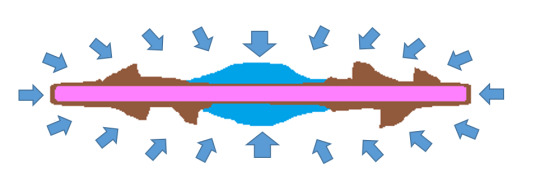
A very ugly drawing of an speculative flat world, with a core made of ~magical~ indistructible material, covered by earth, water and air. Note the direction of gravity and how water flows into a bulge on the center.
This would make for some curious effects; water and air would inevitably flood all the way to the center of the disc, where it would make a bulge, the sea level raising in a notable way there. One way to avoid this is to make the disc spin on its center, like a roulette, the centrifugal force of such a spin would make the gravity spread to the edges. Unfortunately, it's hard to calculate how fast would it be needed for it to 'even out' gravity in the whole disc. I can be sure it would be enough to tear normal worlds made of rock and metal apart, so this flat disc would have to be made of a strong, magical material (which really works well with the mythical 'God set the foundations of the Earth' motif)… or a complex structure of orbital rings inside (ultra-advanced tech artificial structures that transport matter in an opposite way to the spin, generating enough momentum so it doesn't pull apart), or some other kind of exotic matter. The spin would probably would not be noticeable to the inhabitants of the disc in their day to day lives, though, as the 'fixed' stars would move, I'm sure the inhabitants would incorporate in their calendars.
One important thing to remember about gravity is that it's not based in the size of an object, it's based on mass. You could have a (regular) planet smaller than Earth, but with the same gravity, so long as the mass was denser. Similarily you could have huge planets with Earth-like gravity as long as the inside is less dense (bubbleworlds, another thing I'm dying to talk about). So you could have, for example, a disc the size of Earth made of a magical or ultra-tech material (let's call it Newtonlith) where certain places inside the disc would be dense to create gravity fields inside the disc. In a normal setting, this would break it apart, but perhaps, if it's in a form of a spread out gradient, it wouldn't. This would have some very odd effects, which I leave to the reader to imagine.
(I'm of course, dismissing stupid concepts from modern flat earthers such as "Earth perpetually falling down" or "gravity doesn't exist", but I have to say, they do have some wacky worldbuilding)
The Edge and The Other Side:
So, if you get to the edge, gravity would feel strange, making it harder to you to keep going since it's pushing you perpendicularily to the center, until you actuall walk into The Edge, and gravity would feel level. It would be like walking on the oustide of a wheel. However, it's hard for me to imagine what this "edge" would look like. Assuming the disc spins, I would expect the edge to get thinner and thinner, smoothing out rather than being like a sharp "coin-like" edge… or, if it spins fast enough, in fact, more of a sharp cliff or, how could I define this? "Horizontal mountain chain". However, again, we're also assuming this whole thing is made of some magical or ultra-tech material, so the edge might as well be a flat expanse imposible to erode, like a coin edge, which might let you, quite literally, walk around the circle of the Earth. In fact, some enterprising civilizations might make a railroad or transport system all around the circle. Another thing about the Edge is that, because all the water would go to the centers of the disc, it would be very dry, and it also would have winds constantly circulating in the direction of the spin. No wall of ice, at least not as I imagine it; as we'll see later, the temperature on a flat Earth would be rather uniform unless there are other conditions affecting it.
One important thing is that, assuming this is a disc *floating* in space (no elephants or turtles…), is that the other side would be as habitable too. Remember, this case is actually one where the centers of the disc are two poles, and the edge is actually the equator! (HAHAHAHA, TOLD YOU THE EQUATOR WAS IMPORTANT, EVEN IN FLAT WORLDS) So yes, you could, in a way or another, cross over the edge (the equator!) to another whole new world, cross over to The Other Side. Assuming, of course, they get light and such, which is the next point…
Before that, though: regarding horizons; no, there wouldn't be a horizon in a flat world. You could see pretty much all the way until something like mountains block your sight. It's hard to find good estimates on exactly how far though, but humans can make out faint details up to 3km away in good conditions (coincidentially, that's around where the 'horizon' is in our Earth) and lights up to 48km away. Insert your joke about Legolas here.
Orbits, Day, Night and the Sky:
How would day and night work? There are Options.
Again, assuming our magical/ultratech indestructible disc, it could spin on an axis so that each side faces the star it orbits, like a spinning coin. This would be a weird thing, especially if the planet already spins on its edge/equator, but not physically impossible. The orbit of Uranus is similar, with one pole facing the sun during summer and the other during winter, but that means an almost century long day in its case (a year in Uranus is 84 Earth years) and a similar long "day" in an Earth-like orbit. But if this world was created to spin much like Earth, there won't be that much difference between our day and night. You could even tilt it to simulate seasons.

An example of the movements of a flat world given the above; rotation on its axis (that is, the center of the disk, rotation in another axis "like a coin" to give night and day, and revolution around a star. I also went the extra mile and gave it a climate like I will discuss later: a parched edge without water, with increasingly rainy desert, savanna and rainforest as you get to the center, and at last the central sea with a perpetual storm.
But I digress. You probably aren't here for a boring normal planet that orbits a star, no, no. You want the full mythical world experience, you want a world where the Sun and the Moon spin around the circle of the Earth, and fuck Copernicus. Let's leave aside what those 'luminaries' actually ARE for now, they can be some sort of magical tech objects or literal gods. How would that work?
You could have two kinds of luminaries here. The clever folks at the Flat Earth Society imagine a sun and a moon hovering over the Earth, spinning in a circular orbit about what we call the equator (in our round Earth, of course) as some sort of giant spotlight 32 miles across and a few thousand kms away, jumping and falling out of view, as I understand it. Same with the Moon. For a more classical approach, you could also have a sun and a moon orbiting your disc, which would be interesting, as the other side of the disc would also be illuminated while the other one is dark (in many ancient myths, the sun went into the underworld at night)
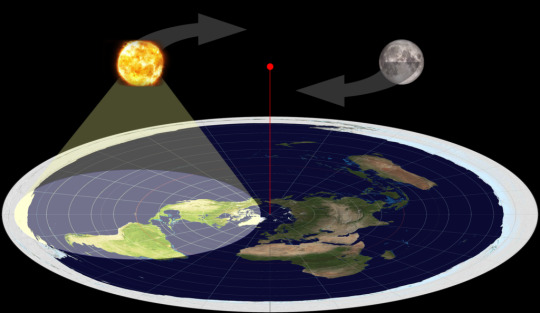
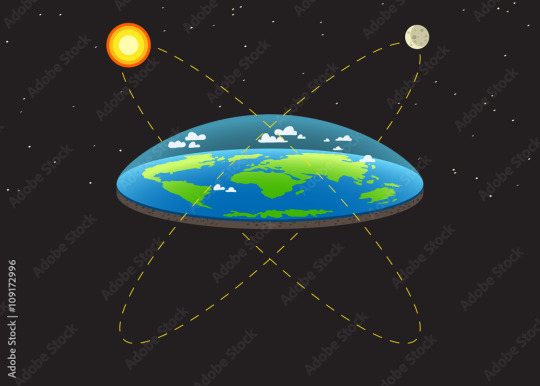
The two ways you could have mini-suns: either hovering above your disk or orbiting it. I was too lazy to make a graphic, so thanks to the Flat Earth Society I guess.
Like I said in the beginning, I haven't done the calculations on how such orbits would work, other that they would be complex, and not natural or stable at all. But after all, suns 32km across that hover over a flat world aren't exactly natural. If there is a place to insert gods and magic shit, this is one, though a fusion or black-hole powered spotlight that completes a very complicated orbit following ancient programming is also an option depending on what kind of setting are you doing. You could watch some videos of people debunking actual flat earthers to get a few ideas on how they explain the whole sun thing (spoilers: they just don't believe in eclipses, which indeed would be impossible here, unless magic is involved).
Both options have VERY important implications on the climate. The first one, with a disc orbiting a star and spinning to get day and night, would mean that the disc would get the same amount of light all over it, thus having the same overall temperature, without any latitudes. The second one(s), depending on the orbits of the suns, means you could have "tropical" areas and cold areas depending on where the sun's "spotlight's" points, either as a regular orbit over an equator, or a more complicated one that might not correspond to what we would expect. Funnily enough, Terry Pratchet's Discworld's sun has such a complicated orbit it's never really explained, it even crosses the legs of the elephants upholding the Discworld sometimes.
Speaking of which, THE Discworld of course moves across space on the back of 4 elephants standing on the shell of Great A'tuin (awesome name for your Torterra in Pokémon btw), and its movement is apparently so significant that the astrologers have to regularly change their zodiacs. And indeed, a flat world would also move around its galaxy if it existed, and carrying its own fantasy sun, it wouldn't need to orbit any star to be habitable. Our own Sun is moving with our entire solar system on tow (or rather orbit) at a speed of, holy shit I had to look this up, 828,000 km/hr. However, even at this speed, the stars seem fixed to us, a whole spin around the center of galaxy (a galactic year) takes 225 million years. Still, the stars are moving like us, in fact, some constellations are in slightly different positions from ancient times, just not at the pace in Discworld.
As a final note, I believe a moon with enough gravitational pull would cause tides as it orbits the flat disc much like on Earth. Would be funny if an actual normal moon like ours orbited a flat world, with a small sun on inside its orbit (not too far from the Ptolemaic universe, actually)
Geology and Climate:
Like I said, we're assuming this flat world is made of either some sort of ultra-tech exotic matter, or was just straight created with magical material. So you would think geology would be pointless to discuss, right? Not so fast. There's some assumptions we can make. First of all, there would be no plate tectonics. Plate tectonics, of course, need an active mantle and core, which a flat world just cannot have at least on the size of Earth. So no earthquakes or volcanoes, unless there's magic involved (Terry's Discworld, which is based on Hindu mythology, played with this by having the elephants holding it up move ocassionally, causing earthquakes) So, a world with less natural disasters, wonderful, right? Sure, but in the long run (millions of years), it's tectonic activity that keeps the Earth alive, replenishing CO2, moving the continents around stimulating evolution and changes in climate and the water cycle. This can be replaced by some magical means, though that means that Something Magical is doing Stuff in your world, (you know, besides the whole flat world thing) and you better contemplate what does it mean for your setting/story. Similarily, one strange thing about geology in flat worlds is that, as mentioned, assuming gravity points to the center(s)/poles, there would be a pull towards there, so mountain peaks would be taller and pointing towards the edge of the disc, and as we will see below, also face greater erosion from there, as the winds and water would also move towards the center/pole.
What about climate? That one depends on how your light sources work. But in general, without poles or equator (well, they exist, but you know), the whole disk surface(s) would recieve equal light all year. Which means no seasons and not climate variation. Seasons are possible by tilting the disc, but overall, the climate in a disc world would be stable. Or would it? By the sheer morphology of a disc, not only water would flow into the center, but also air, and in the case of a spinning disc, it would spin into it. Air would flow into the center into powerful winds: how powerful? Difficult to say, but perhaps geography like mountains and hills could moderate them. If there was no spin, I imagine both water and air would accumulate in a large inner sea (as water would, in one way or the other, flow towards it, and water cannot be denied) and high pressure which could be an odd bulged sea with surprsingly calm weather. However, there's another option. Astronomers have studied tidally locked worlds, worlds where one side faces their star all the time. In this case, the convection currents flows from the light side flow to the dark side, creating strong winds and perhaps, assuming there is water, a perpetual storm in the light side. This has a parallel in our case, as the air in a flat world will all spin around the center, with no other way to go, and with it, it will be where all the heat and energy of the atmosphere (atmodisc?) accumulates. In this world, the center of the world (or at least, this side of it…), the axis mundi, would be the eye of a gigantic eternal typhoon.
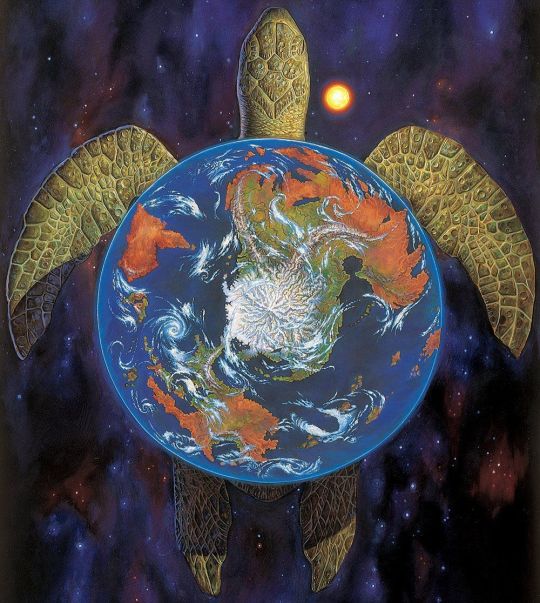
OOOH DISCWORLD I'M HOWLING TO THE MOON
What would geography, life and culture be like in such a world, given all the things I've told you? Well, that's the most fun part. It's up to you to imagine it. I personally don't find flat worlds all that engaging (sorry, Terry), I feel more comfortable with my good old spherical worlds with tropical latitudes and all that, or other more futuristic stuff things like ringworlds or Dyson spheres (which I hope to cover in another post). But I hope I gave you enough information and ideas so that the ones you might create are both original and believable.
Thank you for reading this, I hope you enjoyed it and it inspired you to do some worldbuilding! If you would like to see more, I would be VERY grateful if you gave me a tip and some suggestions in my ko-fi below, especially as my country here in the other side of the disc is under the rule of a libertarian fascist idiot, so every little help does indeed help a lot! Follow me and stay tuned for some more wacky worldbuilding and rants about the Southern Hemisphere.
#cosas mias#worldbuilding#fantasy#writing#writing advice#flat earth#I spent a lot of time on this one so I hope you reblog#and I resisted to post an Earth-chan meme so you should be grateful actually#biotipo worldbuilding
494 notes
·
View notes
Photo
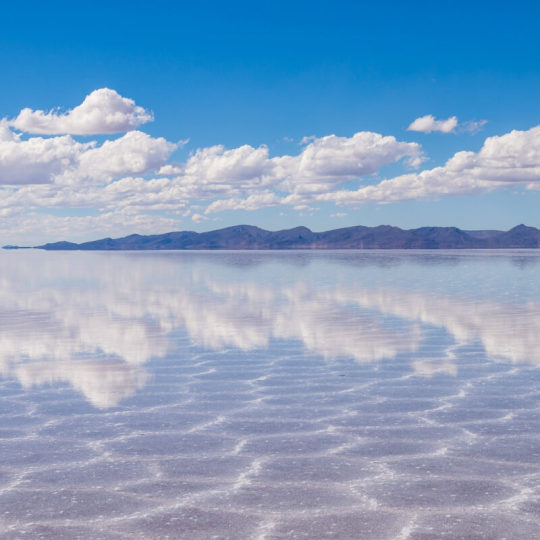



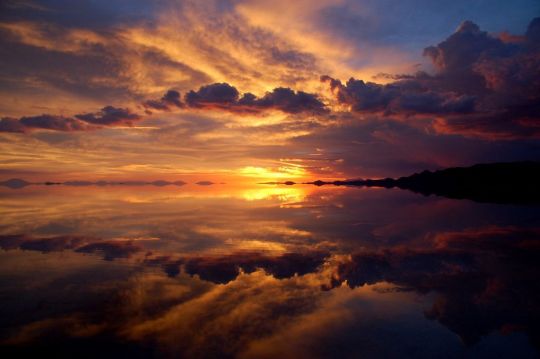
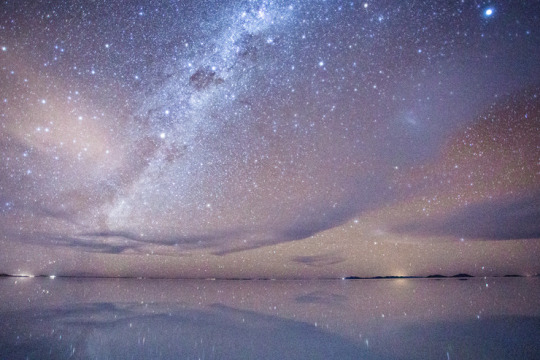
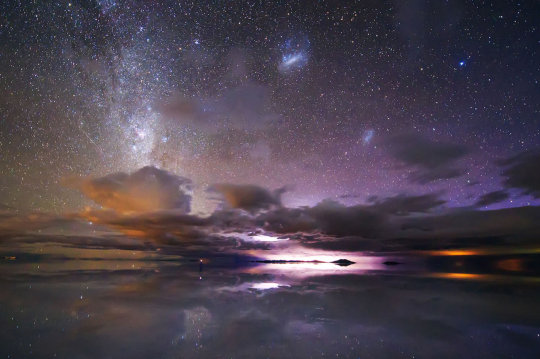


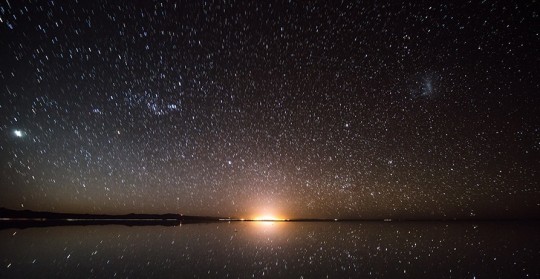
Uyuni Salt Flats, Where You Can Walk On The Sky
#Astronomy#NASA#Night#Sky#Stars#Space#Science#Universe#Cosmos#Cosmic#Solar System#Uyuni Salt Flats#Earth#Nebula#Galaxy#Constellations#Constellation#Rainbow#Bright
2K notes
·
View notes